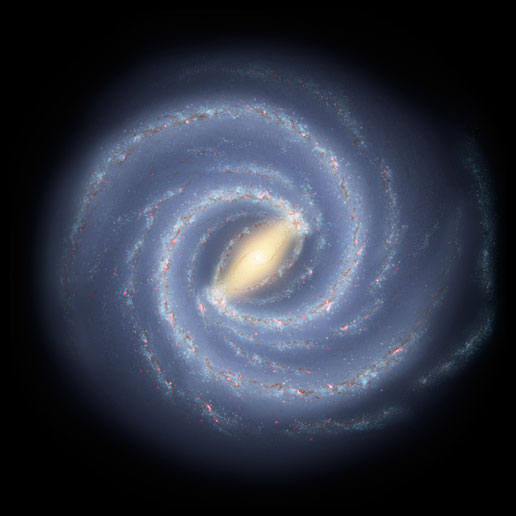The map shows the inner part of the Milky Way has two prominent, symmetric spiral arms, which extend into the outer galaxy where they branch into four spiral arms.
"For the first time these arms are mapped over the entire Milky Way," said Pohl, an Iowa State associate professor of physics and astronomy. "The branching of two of the arms may explain why previous studies – using mainly the inner or mainly the outer galaxy – have found conflicting numbers of spiral arms."
The new map was developed by Pohl, Peter Englmaier of the University of Zurich in Switzerland and Nicolai Bissantz of Ruhr-University in Bochum, Germany.

Like early explorers mapping the continents of our globe, astronomers are busy charting the spiral structure of our galaxy, the Milky Way. Using infrared images from NASA's Spitzer Space Telescope, scientists have discovered that the Milky Way's elegant spiral structure is dominated by just two arms wrapping off the ends of a central bar of stars. Previously, our galaxy was thought to possess four major arms. This artist's concept illustrates the new view of the Milky Way, along with other findings presented at the 212th American Astronomical Society meeting in St. Louis, Mo. The galaxy's two major arms (Scutum-Centaurus and Perseus) can be seen attached to the ends of a thick central bar, while the two now-demoted minor arms (Norma and Sagittarius) are less distinct and located between the major arms. The major arms consist of the highest densities of both young and old stars; the minor arms are primarily filled with gas and pockets of star-forming activity. he artist's concept also includes a new spiral arm, called the "Far-3 kiloparsec arm," discovered via a radio-telescope survey of gas in the Milky Way. This arm is shorter than the two major arms and lies along the bar of the galaxy. Our sun lies near a small, partial arm called the Orion Arm, or Orion Spur, located between the Sagittarius and Perseus arms. Image credit: NASA/JPL-Caltech
As the sun and other stars revolve around the center of the Milky Way, researchers cannot see the spiral arms directly, but have to rely on indirect evidence to find them. In the visible light, the Milky Way appears as an irregular, densely populated strip of stars. Dark clouds of dust obscure the galaxy's central region so it cannot be observed in visible light.
The National Aeronautics and Space Administration's Cosmic Background Explorer satellite was able to map the Milky Way in infrared light using an instrument called the Diffuse IR Background Experiment. The infrared light makes the dust clouds almost fully transparent.
Englmaier and Bissantz used the infrared data from the satellite to develop a kinematic model of gas flow in the inner galaxy. Pohl used the model to reconstruct the distribution of molecular gas in the galaxy. And that led to the researchers' map of the galaxy's spiral arms.
The Milky Way is the best studied galaxy in the universe because other galaxies are too far away for detailed observations. And so studies of the galaxy are an important reference point for the interpretation of other galaxies.
Astrophysicists know that the stars in the Milky Way are distributed as a disk with a central bulge dominated by a long bar-shaped arrangement of stars. Outside this central area, stars are located along spiral arms.
In addition to the two main spiral arms in the inner galaxy, two weaker arms exist. These arms end about 10,000 light-years from the galaxy's center. (The sun is located about 25,000 light-years from the galactic center.) One of these arms has been known for a long time, but has always been a mystery because of its large deviation from circular motion. The new model explains the deviation as a result of alternations to its orbit caused by the bar's gravitational pull. The other, symmetric arm on the far side of the galaxy was recently found in gas data.
The discovery of this second arm was a great relief for Englmaier: "Finally it is clear that our model assumption of symmetry was correct and the inner galaxy is indeed quite symmetric in structure."
Other scientific groups are already interested in using the new map for their research. A group from France, for example, hopes to use it in their search for dark matter.





Comments